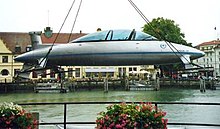Skid boat

The Gleitkufenboot Sizzling 42 and its successors of Felix Wankel from 1942 developed Boots - prototypes that related to hydrofoils are.
Originally, Zisch was supposed to be a weapon of war . A 1.2 m long model boat was labeled as Zisch 2 , which Wankel had shown in January 1970 when he presented his plan for an unsinkable, winter-proof and ocean-proof boat for everyone to use at speeds of up to 100 km / h.
Hiss 42
The first test boat had a special device for generating dynamic buoyancy and an associated reduction in frictional resistance , the so-called skids . These wings looked similar to those of hydrofoil boats, but were designed so that the top of the profile is out of the water at full speed. Through the employment of the skids was compression lift used. The skids only touch the water surface with the underside. This also prevented cavitation problems on the profile. The skids could be swiveled upwards by 180 °, which reduced the draft. The Zisch 42 was tested on Lake Constance in 1945 .
Hiss 68
The Zisch 68 has two sliding surfaces arranged one behind the other. This resulted in too much stretching, which led to strong impacts. This driving behavior was very uncomfortable for the passengers. There were also stability problems in curves. A marine Ro135 rotary engine with 200 hp (147 kW) charged with a turbocharger was used in the Zisch 68 .
Hiss 69 B
In June 1972, the press reported from the Wankel workshops and showed a 1.2 m long model boat with the Zisch 69 B logo in action, which had sailed on Lake Constance .
Hiss 74
Felix Wankel then carried out further experiments with the split skid / split sliding surfaces, which manifested themselves in the Zisch 74 in 1974 . The wing of the barn owl was the inspiration for the principle of the split skids. The Zisch 74 was powered by a Mercedes-Benz DB M950 KE409 four-disc rotary engine that had been throttled from 350 hp to 250 hp (184 kW). A special feature was the air supply through an air fin located above in the rear area. Like the "nostrils" in the front of the test boat "Tiger Shark" presented in 1968, this could be closed by flaps, which were controlled from sensors in the front (motors with propeller-like crosses). As a result, no water could penetrate when driving through waves. It was not possible to capsize the boat with a speed of over 100 km / h because it straightened up from any position due to its center of gravity.
In addition, a conventional sports boat was modified and provided with split skids.
Web links
Individual evidence
- ^ Sascha Becker: Games, technology and war . Tectum Verlag, 2013, ISBN 978-3-8288-3232-9 , pp. 363 ff . ( Table of contents [PDF; 259 kB ] dissertation ).
- ↑ Like the fish . In: Der Spiegel . No. 4 , 1970, pp. 144 ( online ).
- ↑ Max Fehlmann: Dr. Wankel Re-Invents the Boat . In: Popular Science . June 1972, p. 58-60 ( books.google.de ).
